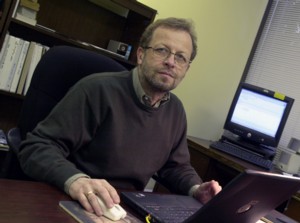
Jacek Sekutowicz, visiting senior staff scientist at Jefferson Lab's Institute for Superconducting Radiofrequency Science and Technology
Jacek Sekutowicz, one of the world's acknowledged experts in superconducting technology, is helping Jefferson Lab staff design and refine the next generation of niobium cavities as part of a proposed 12 GeV upgrade to the Lab's accelerator.
Jacek Sekutowicz knows well how a life's course can be set by an inspirational mentor. Currently a visiting senior staff scientist at Jefferson Lab's Institute for Superconducting Radiofrequency Science & Technology in Newport News, Va., Sekutowicz clearly remembers when, as a 16-year-old high schooler in Warsaw, Poland, he became captivated by applied physics. "I had a very good teacher," he recalls. "Maybe that's what convinced me. Accelerators were just very interesting to me. It was fascinating to know you could move a particle almost at the speed of light."
As he grew older, Sekutowicz amplified that interest, first by getting a Master's degree in Microwave Electronics at Warsaw Technical University in 1973 and then a Master's degree in Mathematics in 1981 at Warsaw University. While working at the Institute for Nuclear Studies on medical accelerators, he had nearly completed a Ph.D. in physics - an effort interrupted in 1985 just before the final examination by a job offer at DESY (the Deutsches Elektronen Synchrotron) in Hamburg. The degree was completed later when he decided to stay in Germany for good. "I came to Hamburg for one year only," he says. "And now, it is almost 18 years later and I am still there."
As one of the world's acknowledged experts in superconducting technology, Sekutowicz is currently helping Jefferson Lab design and refine the next generation of niobium cavities as part of a proposed 12 billion electron volt (12 GeV) upgrade to the Lab's accelerator. The accelerator upgrade is the first step in a process that will enable Jefferson Lab researchers to push beyond the frontiers where they now delve into quark-related physics.
"When I'm needed I give advice," Sekutowicz says. "The projects here are very, very interesting, with some of the best people working on them: like Peter Kneisel and Lia Merminga, and with a young new generation of scientists like Genfa Wu and many gifted engineers and technicians. So I was happy when JLab management gave me this opportunity to visit the Lab for a while. The collaboration is very good; it began a few years ago when the Lab started to work on the Spallation Neutron Source project and asked for my involvement. I'm excited and I'm satisfied. We have a turbulent time now; so many things happen here. I hope and believe our collaboration won't stop after I return to DESY in a year or so."
Sekutowicz is participating in the design of new cavities and devices known as high-order mode couplers, which he and his colleagues believe are needed to reduce or eliminate "parasitic" modes: electromagnetic oscillations set up by the accelerated beam as it passes through the cavities. These oscillations can, like the backwash of water in a storm-tossed bay cutting off the tops of wind-tossed waves, reflect back on the beam and degrade its quality. The designers' ultimate goal is to harness these resultant electromagnetic fields in order to insure highly efficient beam passage through the cavities.
The cavities made of superconducting niobium are the innermost part of a three-part cryomodule system that includes a cooling tank of liquid helium and a vacuum vessel known as a cryostat that provides insulation to allow the cavities to remain cooled to two Kelvin, or nearly absolute zero. At such a temperature, the microwaves that are introduced to speed the electron beam lose very little of their energy to the cavities' superconducting wall, accelerating charged particles with far greater efficiency than would non-supercooled copper cavities.
"At the moment, JLab is one of the best laboratories in the world for RF superconductivity," Sekutowicz says. "We have a great opportunity to push the technology, to achieve lower cryogenic losses and higher accelerating gradients. It improves performance and saves money."
As part of a 12-nation collaboration led by DESY, Sekutowicz has worked the last three years on a project team studying the feasibility of using novel accelerating cavities to create a trillion-electron-volt, or TeV, linear collider known as TESLA. The Tera Electron Volt Energy Superconducting Linear Accelerator is based on the early work of internationally recognized accelerator physics and superconductivity expert Maury Tigner, professor of physics emeritus at Cornell University. Work in the area was reinvigorated at Cornell 10 years ago during a workshop organized by Hasan Padamsee, adjunct professor of physics. (Both men have been very involved with Jefferson Lab over the years and Tigner has been a member of many review boards.)
The test of these new cavities was carried out last year at DESY, with results that are "very encouraging," according to Sekutowicz. A similar new accelerating structure could be adapted to Jefferson Lab's Free-Electron Laser, or FEL. Future FEL upgrades could incorporate two interlinked five-cell cavities with fewer higher order mode couplers to ensure a high quality electron beam for the FEL. "We've already made a copper model that has tested well," Sekutowicz says. "The next step will be to fabricate a niobium prototype and test it. If all goes as hoped, we could have the prototype by this summer."
James Schultz

